By Richard L. Cruess, MD
The history of medicine in Montreal and the history of McGill University are closely intertwined. The Hôtel-Dieu Hospital had been established in 1644, but by the early 1800's it could only house thirty patients(1) and was unable to accommodate growing patient needs. In addition, there was no hospital for the English-speaking community. In 1801, Quebec's parliament established the Royal Institution for the Advancement of Learning, a volunteer-run Protestant organization dedicated to stimulating secondary and advanced education in the province. It was created in response to pressure from English-speaking Montrealers, but produced no concrete results until 1811 when James McGill, a prominent fur trader, bequeathed his country estate (McGill's downtown campus today) and ten thousand pounds for the endowment of the university that would bear his name. In 1821, a charter was granted, McGill College was given university powers and a governing board was appointed.
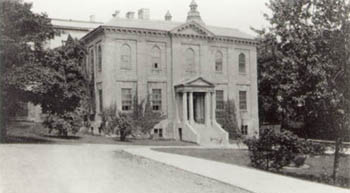
Meanwhile, other events had been afoot in the community. In 1819, public-spirited citizens had established the Montreal General Hospital, which moved into a new building in 1822. In 1823, four Edinburgh-trained physicians working at the Montreal General established the "Montreal Medical Institution," a proprietary medical school. James McGill had wisely stipulated that his university must be functioning within 10 years of his death, or the property and money would revert to his wife's children. In 1829, the Montreal Medical Institution was incorporated into McGill College as the Faculty of Medicine, ensuring that the estate and endowment would remain intact for educational purposes. It became the first Faculty of Medicine in the country(2).
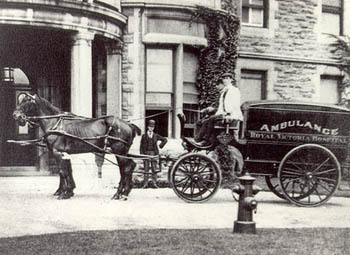
Over the next 20 years, the Faculty of Medicine was described as "the most dynamic faculty at McGill College(1)." The Edinburgh curriculum was instituted, thus ensuring a highly didactic approach to education involving two six-month courses of basic science lectures and two years of "walking the ward." Research started early, beginning with ether experiments in 1848, and research has been taking place there ever since. In 1855, Sir William Dawson was appointed Principal of McGill University. He personally transformed a Victorian institution into a modern internationally recognized university. He began by raising resources, a tradition which persists today. As a result, the Faculty of Medicine acquired a new medical building, the Royal Victoria Hospital opened in 1894, and endowed chairs in Hygiene and Pathology were established. The size of the Medical Library also tripled and young graduates began heading to Europe for post-graduate training before continuing their studies at McGill.
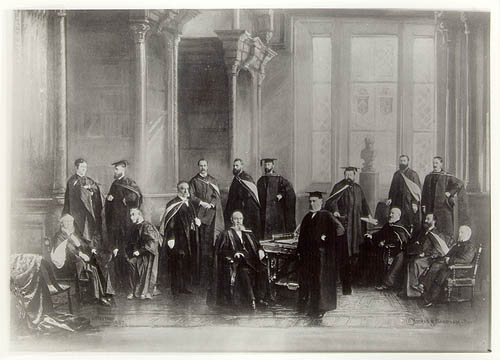
Medical education in the mid- and late 1800's was very different from the training we provide today(3). Students paid tuition to their professors, instruction was largely didactic, there was little or no bedside teaching, and the scientific foundations of modern medicine were not yet present. It is doubtful that any of the North American medical faculties were truly outstanding at that time, but as science expanded and medicine grew closer to science, changes were afoot. As is well-documented(3,4), these changes occurred simultaneously in the leading schools on the continent, including McGill. Although the intellectual stimulus for change came from Europe, the changes were actually effected by the vigorous and competent young physicians returning to North America from training abroad.

At McGill, the outstanding individual was of course Sir William Osler, but Francis Shepherd, George Ross and Thomas Roddick joined him and remained when he moved to the University of Pennsylvania in 1884, later heading to Johns Hopkins and Oxford. In line with trends elsewhere, and under Dawson's direction, the medical school became a fully-integrated part of the academic world, functioning in a university setting with exacting standards of learning. The old days of proprietary instruction were gone, as were the days of accepting unqualified students for training. Osler established the first physiology laboratory in Canada, wrote a student handbook in histology, and was the first pathologist at McGill and the Montreal General, as well as our first "full-time faculty member." Roddick was the first to use asepsis in surgery and established the Medical Council of Canada later in his career.

While the Faculty of Medicine was certainly competitive on the international scene, so were many other aspects of teaching and research at McGill. Rutherford had made major contributions to atomic theory, Leacock occupied an endowed chair in political economy, and Cox was using x-rays just four months after their discovery in 1895.
When Flexner visited McGill in 1905 and wrote his report in 1910(5), the faculty was housed in the new Strathcona Medical Building and had both The Montreal General Hospital and the extremely modern Royal Victoria Hospital at its disposal. McGill was given a Class A rating.

Growth slowed during World War I, but resumed at the end of hostilities. Sir Arthur Currie, McGill's Principal, raised a large amount of money for the university, including a grant from the Rockefeller Foundation. These resources were used to increase salaries, and to build and staff a new biology building, a pathological institute and the University Clinic for Research in Internal Medicine, located at the Royal Victoria Hospital. In 1924, Canadian-born Jonathan Meakins was recruited from Edinburgh to become the Physician-in-Chief at the Royal Victoria Hospital and the first full-time clinical professor at McGill. Meakins recruited outstanding young clinician-scientists and laid the groundwork for McGill's commitment to combining research with excellence in clinical medicine.

Edward Archibald became Surgeon-in-Chief at the Royal Victoria Hospital and Chair of the Department at McGill, and also recruited an unusual group of surgeon-scientists including Penfield, Bethune, Webster, future-Principal Rocke Robertson and Arthur Vineberg, who pioneered revascularization. Penfield's presence attracted the Rockefeller grant that built and staffed the Montreal Neurological Institute, which opened its doors in 1934.
The Depression slowed University activities, but teaching continued and post-graduate programs were established in most major disciplines in spite of the sharp economic downturn.
World War II once again interrupted activities, and following the end of the war, McGill found itself with facilities in dire need of modernization. In 1955, The Montreal General Hospital moved from its quarters on Dorchester Street to a modern building nestled on the side of Mount Royal. The Royal Victoria Hospital launched major campaigns to replace most of its clinical facilities, and expanded research areas over a period of 20 years. The Montreal Children's Hospital, originally acquired as a teaching facility, moved to relatively new quarters on Tupper Street and greatly expanded its research space and resources.
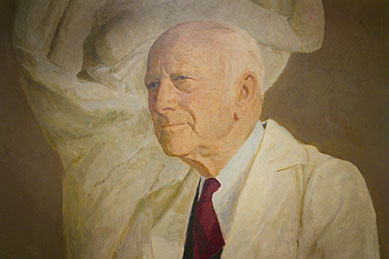
The North American trend toward developing a large cadre of full-time faculty members had an impact on Medicine at McGill. At The Montreal General, Physician-in-Chief Douglas Cameron recruited an outstanding group of young investigators including Burgen, Freedman, Gold, Hollenberg, Aguayo, Skamene and others. At the Royal Victoria Hospital, Dr Meakins retired and was eventually replaced by Drs. Christie and Beck, both of whom ensured continued research excellence. They attracted outstanding researchers including Bates, Macklem, Solomon, Gutman, Cooper, Posner, Patel, McKenzie and Goltzman. Surgery flourished under the direction of Drs. L.D. MacLean and Meakins at the Royal Victoria Hospital and Rocke Robertson, Gurd, and Mulder at The Montreal General. In addition, as both institutions moved into modern times, pioneering clinical epidemiology units were added both to carry out independent research and to support clinical research in the major departments.
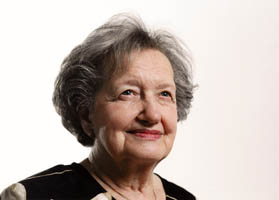
The Montreal Neurological Institute also grew and developed with several new facilities and a strong research base. Under the direction of Drs. Rasmusen, Feindel and Murphy, the tradition of housing patient care and research under the same roof was continued. An outstanding neuro-imaging group was developed and new laboratories in neurochemistry were constructed, staffed by Wolfe and others. Neuropsychology, under Brenda Milner, received international recognition. In neurosurgery, the neurosurgical approach to epilepsy continued to produce knowledge recognized throughout the world.
The basic sciences at McGill had remained strong and continue in this tradition today. Tracing its roots back to Osler, the splendid tradition of pathology was developed later by renowned investigators such as Gardiner McMillen and others. Biochemistry, pharmacology and physiology boast a long tradition of contributions pioneered by MacIntosh, Nickerson, Graham and others, continued today by Drs. Krnjevič, Cuello, Sonenberg and Gros. The tradition of morphological investigation, so brilliantly begun by C. P. LeBlond and his successors, continues as well.
The modern era has seen the emergence of hospital-based research institutes as powerful forces, making them equal partners with the basic science departments. Support from the Fonds de la recherche en santé du Québec has been important, as has the continued competitiveness of all aspects of McGill's scientific endeavours. New institutions have taken up our research mission, and the Lady Davis Research Institute of the Sir Mortimer B. Davis Jewish General Hospital is on par with its two older siblings. The Research Institute of the Douglas Hospital is recognized throughout the world for its contributions to neuroscience and psychiatric research, and the Shriners Hospital for Children contains one of the largest and most successful units in the world devoted to research on crippling diseases. In addition, new university centres have been created to promote interdisciplinary research. One such centre, focusing on genetics, has risen to prominence through the exceptional work of Clarke Fraser, Charles Scriver and others. Centres and institutes in the fields of cancer, nutrition, medicine, non-linear dynamics and ethics and law have all played a major role in McGill's continuing contributions to human knowledge.

At present, like most educational institutions, McGill is concerned about financing. In all human endeavours, the way in which one copes with problems is more important than the problems themselves. If the Faculty leverages its considerable ingenuity, McGill will push confidently into the future - perhaps with new structures and new organizations, but always with a continued commitment to excellence.
See a List of Deans of the McGill Faculty of Medicine from 1854 to the present day.
References:
1. McPhedran N. Tait. Canadian Medical Schools: Two Centuries of History, 1827-1992. Montreal Harvest House, 1993.
2. Hanaway J. and Cruess R. McGill Medicine: The First Half Century: 1829-1885. Montreal, McGill-Queens Press, 1996.
3. Bonner T. N. Becoming a Physican. Medical Education in Great Britain, France, Germany and the United States, 1750-1945. New York, Oxford University Press, 1995.
4. Ludmerer, K.M. Learning to Heal. The Development of American Medical Education. New York, Basic Books, 1985.
5. Flexner A. Medical Education in the United States and Canada. New York, Carnegie Foundation for the Advancement of Teaching, Bulletin No. 4, 1910.